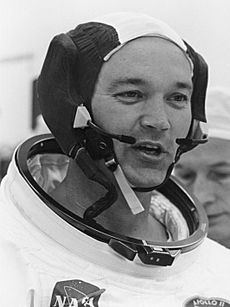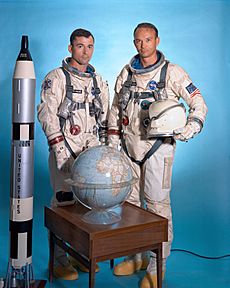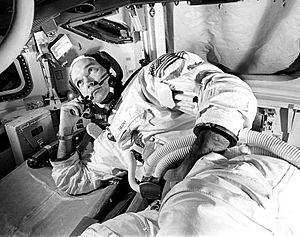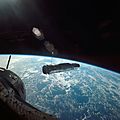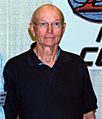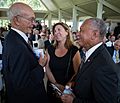Michael Collins (astronaut) facts for kids
Quick facts for kids
Michael Collins
|
|
|---|---|
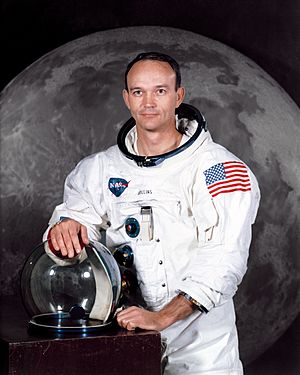
Portrait of Collins in a spacesuit taken on April 16, 1969, three months before the launch of Apollo 11
|
|
| 12th Assistant Secretary of State for Public Affairs | |
| In office January 6, 1970 – April 11, 1971 |
|
| President | Richard Nixon |
| Preceded by | Dixon Donnelley |
| Succeeded by | Carol Laise |
| Personal details | |
| Born | October 31, 1930 Rome, Kingdom of Italy |
| Died | April 28, 2021 (aged 90) Naples, Florida, U.S. |
| Spouse |
Patricia Finnegan
(m. 1957; died 2014) |
| Children | 3, including Kate |
| Relatives | James Collins (father) James Collins Jr. (brother) J. Lawton Collins (uncle) |
| Education | United States Military Academy (BS) |
| Signature | |
| Military service | |
| Allegiance | |
| Branch/service | |
| Years of service | 1952–1970 (active duty) 1970–1982 (reserve) |
| Rank | |
| Awards |
|
| Space career | |
| NASA Astronaut | |
|
Time in space
|
11 days, 2 hours, 4 minutes, 43 seconds |
| Selection | 1963 NASA Group 3 |
|
Total EVAs
|
2 |
|
Total EVA time
|
1 hour 28 minutes |
| Missions | Gemini 10, Apollo 11 |
|
Mission insignia
|
 |
Michael Collins (born October 31, 1930 – died April 28, 2021) was an American astronaut. He flew the Apollo 11 command module Columbia around the Moon in 1969. His crewmates, Neil Armstrong and Buzz Aldrin, made the first landing on the Moon's surface. Collins was also a test pilot and a major general in the U.S. Air Force Reserves.
Collins graduated from the United States Military Academy in 1952. He then joined the United States Air Force. He flew F-86 Sabre fighter jets in France. In 1960, he was accepted into the U.S. Air Force Experimental Flight Test Pilot School. He also graduated from the Aerospace Research Pilot School.
In 1963, NASA chose Collins as part of their third group of 14 astronauts. He flew into space two times. His first spaceflight was on Gemini 10 in 1966. On this mission, he and Command Pilot John Young met up with two spacecraft in orbit. Collins also did two spacewalks.
On the 1969 Apollo 11 mission, he became one of 24 people to fly to the Moon. He orbited the Moon thirty times. He was the fourth person (and third American) to do a spacewalk. He was also the first person to do more than one spacewalk. After John Young, he was the second person to orbit the Moon alone.
After leaving NASA in 1970, Collins worked for the Department of State. He was the Assistant Secretary of State for Public Affairs. A year later, he became the director of the National Air and Space Museum. He held this job until 1978. Then he became the undersecretary of the Smithsonian Institution. In 1980, he became vice president of LTV Aerospace. He left in 1985 to start his own business.
Collins received many awards. These include the Presidential Medal of Freedom in 1969 and the Congressional Gold Medal in 2011. He received these awards with his Apollo 11 crewmates.
Michael Collins died from cancer on April 28, 2021, in Naples, Florida. He was 90 years old.
Contents
Becoming an Air Force Pilot
Collins went to the United States Military Academy. After his training, he joined the United States Air Force. He flew F-86 fighter jets. He was stationed at Chambley-Bussieres Air Base in France.
In 1960, he got into the USAF Experimental Flight Test Pilot School. This school is at Edwards Air Force Base. He tried to join the second group of astronauts but was not chosen. However, he was accepted into the third group.
Joining the Astronaut Program
Collins joined the third group of fourteen astronauts in 1963. Their training started with a 240-hour course. This course taught them the basics of spaceflight. About 58 hours of training focused on geology. Collins found geology difficult and was not very interested in it.
After this basic training, the astronauts were given special jobs. Collins chose to work on pressure suits and spacewalks (EVAs). His job was to watch how these were developed. He also connected the Astronaut Office with the companies making the suits.
In June 1965, Collins got his first crew assignment. He was the backup pilot for Gemini 7. He was the first of his group to get a crew assignment. However, he was not the first to fly into space. That honor went to David Scott on Gemini 8.
Gemini 10 Mission
On January 24, 1966, Collins was assigned to the main crew of Gemini 10. He flew with John Young. Their mission was planned for three days. They had to meet up with two different Agena Target Vehicles in space. They also had to do two spacewalks and 15 different experiments.
Their training went well. They learned how to meet other spacecraft in orbit. Collins also practiced for his spacewalks. For his first spacewalk, Collins did not leave the Gemini capsule. He stood up through the hatch. He used a device that looked like a sextant. He said he felt like a Roman god riding in his chariot. This spacewalk started on the dark side of Earth. Collins wanted to take photos of the Milky Way. But his eyes started tearing up, so the spacewalk ended early.
Before Collins' second spacewalk, the Agena spacecraft was let go. Young moved their capsule close to another Agena spacecraft. This was Agena 8. Collins was attached to a 49-foot cord. He thought tasks took much longer than he expected during the spacewalk. He took a micro-meteor experiment from the outside of the spacecraft. He also set up his nitrogen thruster for moving around. Collins had trouble getting back into the spacecraft. Young had to pull him back in with the cord. After this, they did more experiments. Then, they landed in the Atlantic Ocean.
Apollo Program Missions

After Gemini 10, Collins was assigned to the backup crew for the second manned Apollo flight. He was the Lunar Module Pilot (LMP). His crewmates were Commander Frank Borman and Command Module Pilot (CMP) Thomas Stafford. Collins also received helicopter training. This was thought to be the best way to practice landing the Lunar Module.
Later, the Apollo 2 flight was canceled. Collins was then moved to the CMP position for the Apollo 8 prime crew. His new crewmates were Borman and William Anders. This change meant Collins would orbit the Moon while Armstrong and Aldrin walked on its surface during Apollo 11.
On January 27, 1967, Collins was at a staff meeting. He learned there was a fire in the Apollo 1 spacecraft. Three astronauts died in this fire. Collins had the difficult job of telling Martha Chaffee that her husband had died.
In May 1967, NASA sent Collins and David Scott to the Paris Air Show. There, they met cosmonauts Pavel Belyayev and Konstantin Feoktistov. They drank vodka together. Collins found it interesting that some cosmonauts also trained with helicopters.
Apollo 8 Flight
Collins was a capsule communicator (CAPCOM) for Apollo 8. A CAPCOM is an astronaut at Mission Control. They talk directly with the crew during a mission. Collins covered the launch phase. He also covered the rocket burn that sent Apollo 8 to the Moon.
After Apollo 8 successfully flew around the Moon, the Apollo 11 crew was announced. It included Armstrong, Aldrin, and Collins. At that time, it was not certain this would be the crew to land on the Moon. It depended on the success of Apollo 9 and Apollo 10. These missions would test the Lunar Module.
Apollo 11 Mission
As the Command Module Pilot (CMP), Collins's training was different from Armstrong's and Aldrin's. They trained for the Lunar Module and spacewalks. Collins's training included simulators and centrifuge training. This simulated the strong forces of reentry. He also practiced docking with a large setup at NASA Langley Research Center.
Collins created the famous mission patch of Apollo 11. Jim Lovell, the backup commander, suggested using eagles. Collins liked the idea. He found a painting of an eagle in a National Geographic book. He traced it and added the Moon's surface below and Earth in the background. The idea of an olive branch, a symbol of peace, came from a computer expert. The name Columbia for the spacecraft came from Julian Scheer, a NASA official.
During his day flying alone around the Moon, Collins never felt lonely. He wrote in his autobiography that he felt very much a part of the mission. He said, "this venture has been structured for three men, and I consider my third to be as necessary as either of the other two." For 48 minutes of each orbit, he was out of radio contact with Earth. He reported feeling "awareness, anticipation, satisfaction, confidence, almost exultation."
Collins felt he needed to leave his mark on the spacecraft. So, after returning from the Moon, he wrote inside the command module:
- "Spacecraft 107 — alias Apollo 11 — alias Columbia. The best ship to come down the line. God Bless Her. Michael Collins, CMP"
In a 2009 interview, Collins said he was very worried about Armstrong and Aldrin's safety. He was also concerned that if they died on the Moon, he would have to return to Earth alone. He thought he would be seen as "a marked man for life" as the mission's only survivor.
Life After NASA
Collins left NASA in 1970. He took a job in the Department of State. He was the Assistant Secretary for Public Affairs. A year later, he became the director of the National Air and Space Museum. He held this job until 1978. Then he became the undersecretary of the Smithsonian Institution. In 1980, he became the Vice President of LTV Aerospace. He left in 1985 to start his own business.
He was married to Patricia. They had three children: Kate, Ann, and Michael, Jr. Kate is an actress. She is known for her role as Natalie Marlowe Dillon in the TV show All My Children.
Images for kids
-
ARPS Class III graduates. Front row: Ed Givens, Tommie Benefield, Charles Bassett, Greg Neubeck and Collins. Back row: Al Atwell, Neil Garland, Jim Roman, Al Uhalt and Joe Engle
-
John Young (left) and Michael Collins aboard the recovery ship
-
Collins (center) with William Anders (left) and Frank Borman (right)
-
The crew of Apollo 11: from left to right, Neil Armstrong, Michael Collins and Buzz Aldrin.
-
The Milestones of Flight Hall of the National Air and Space Museum in Washington, D.C.
-
Collins, NASA Deputy Administrator Lori Garver and NASA Administrator Charles Bolden at a memorial service for Neil Armstrong in 2012
-
Collins during the Congressional Gold Medal ceremony in the Rotunda at the U.S. Capitol on November 16, 2011
-
Collins with President Donald Trump, Vice President Mike Pence and NASA Administrator Jim Bridenstine in July 2019
See also
 In Spanish: Michael Collins (astronauta) para niños
In Spanish: Michael Collins (astronauta) para niños


